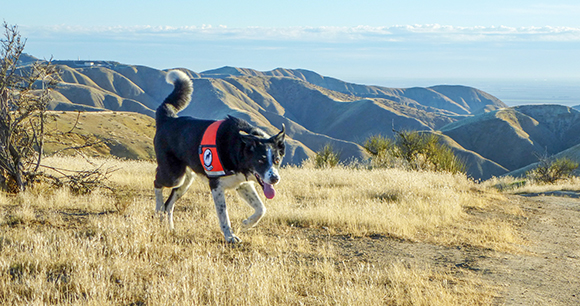by Dr. Ngaio L. Richards and Dr. Deborah Woollett
San Joaquin kit foxes know auspicious habitat when they see it, but would not know if it is free of harmful anticoagulant rodenticide baits or of prey contaminated with rodenticide residue. That’s where Working Dogs for Conservation’s talented fleet of kit fox scat detection dogs are invaluable.

For nearly two decades, Working Dogs for Conservation has noninvasively monitored the San Joaquin kit fox, an endangered species, using three generations of specially trained dogs. The dogs have helped us obtain key information on population density and occurrence within the San Joaquin Valley of California, the only place this small fox calls home. Mapping and genetic analyses of hundreds of dog-detected scats led to over $2.5 million being levied to purchase and permanently protect vital habitat and buffer areas.
However, the potential presence of rodenticides in these and other habitats would undermine even the most steadfast of conservation efforts.
An analysis of 68 kit fox carcasses collected opportunistically over 24 years revealed exposure to rodenticides in an urban population. Another study determined anticoagulants were detectable in fox feces. We built on both, using our dogs’ tremendous scat-finding capabilities to noninvasively and scrupulously investigate the threat rodenticides may pose to populations in more natural habitats.
In 2016, using funds provided through AWI’s Christine Stevens Wildlife Award, we surveyed habitat chosen to reflect varying degrees of human usage, including protected lands. In total, 670 kit fox scat finds were recorded, with 170 fresh enough for rodenticide analysis and 126 suitable for genetic analysis.
All the tested scat samples came back negative for rodenticides. That may be a harbinger of excellent news but, to be certain, our dogs continue to be used to find kit fox scats. A single rodenticide-positive scat would be cause for concern, and our results do not completely rule out exposure opportunities for kit fox within our surveyed areas. Consequently, as we collect additional scats they are being subject to more sensitive analyses to be sure we are not missing any trace-level exposure.
In addition to these future plans, we designed this current phase of surveys to offer multiple avenues of important data. Invaluable genetic information has been obtained from recently deposited fresh scats. And the many older scats found by our dogs, although not viable for rodenticide analysis, are precious indicators of longer-term presence and distribution. In fact, our scat data have already paid dividends, having been included in a presentation at a recent Wildlife Society workshop specifically centered on San Joaquin kit fox ecology and conservation.
Given our longstanding commitment to this species and participation in conservation efforts, we have a keen interest in its future management. We, and our dogs, will continue to investigate, because it is imperative that kit fox—and, indeed, all wildlife—have access to the safe, high-quality habitat to which they are entitled.